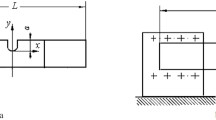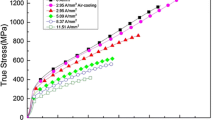Abstract
Results of experimental evaluation of the pulse current effect on stress levels in a stretched steel strip are presented. At the stage of growing loads, stress relaxation in the strip is shown to increase with current densities and loads. After a stepwise decrease in loads, pulse current passage causes an increase in tensile stresses rather than their relaxation. It was suggested that loading and further unloading result in microplastic strains of different directions, which become apparent upon pulse current passage. The phenomenological model of the metal behavior describing the pulse current effect upon loading and unloading is proposed.
Similar content being viewed by others
References
V. N. Spitsin and O. A. Troitskii, Electroplastic Deformation of Metals [in Russian], Mashinostroenie, Moscow (1985).
N. N. Beklemishev, N. I. Koryagin, and G. S. Shapiro, “Influence of a local nonuniform pulsed electromagnetic field on the plasticity and strength of conducting materials,” Izv. AN SSSR, Ser. Metally, No. 4, 184–187 (1981).
K. M. Klimov and I. I. Novikov, “Plastic deformation of metals in the electromagnetic field,” in: Theses V All-Union Congress on Theoretical and Applied Mechanics, Nauka, Alma—Ata (1981), pp. 190–194.
V. E. Gromov, L. B. Zuev, V. I. Bazaikin, and V. Ya. Tsellermaer, “Relationships of current-induced plastic strain of metals and alloys at different structural levels,” Izv. Vuzov, Fizika, No. 3, 66–96 (1996).
A. A. Kopanev, “Nature of the electroplastic effect in metals,” Strength Mater., 23, No.1, 55–59 (1991).
G. V. Stepanov and A. I. Babutskii, “Effect of electric current on stress relaxation in metals,” Strength Mater., 28, No.2, 125–128 (1996).
V. A. Strizhalo, L. S. Novogrudskii, and E. V. Vorob'ev, Strength of Alloys for Cryogenic Engineering under Electromagnetic Effects [in Russian], Naukova Dumka, Kiev (1990).
G. V. Stepanov, A. I. Babutskii, and I. A. Mameev, “High-density pulse current-induced unsteady stress-strain state in a long rod,” Strength Mater., 36, No.4, 377–381 (2004).
G. S. Pisarenko, A. P. Yakovlev, and V. V. Matveev, Vibration-Absorbing Properties of Structural Materials [in Russian], Naukova Dumka, Kiev (1975).
Author information
Authors and Affiliations
Additional information
__________
Translated from Problemy Prochnosti, No. 6, pp. 61 – 67, November – December, 2005.
Rights and permissions
About this article
Cite this article
Stepanov, G.V., Babutskii, A.I., Mameev, I.A. et al. Pulse Current Effect on Stress Levels in a Metal Strip in Tension. Strength Mater 37, 593–597 (2005). https://doi.org/10.1007/s11223-006-0006-9
Received:
Issue Date:
DOI: https://doi.org/10.1007/s11223-006-0006-9




